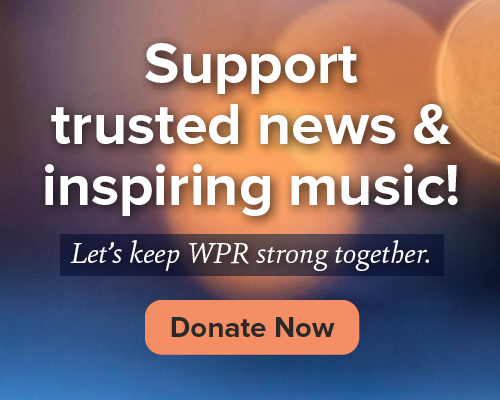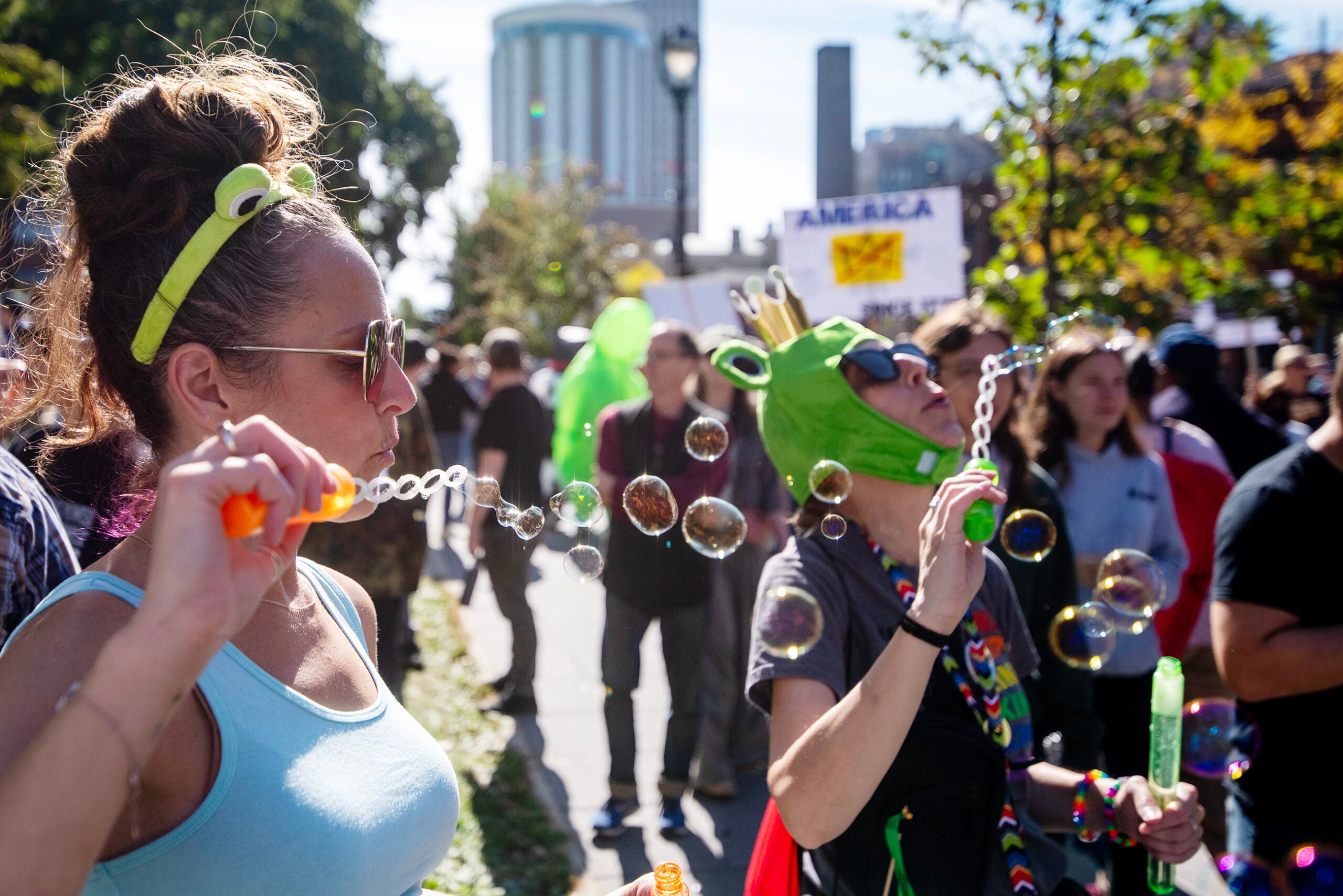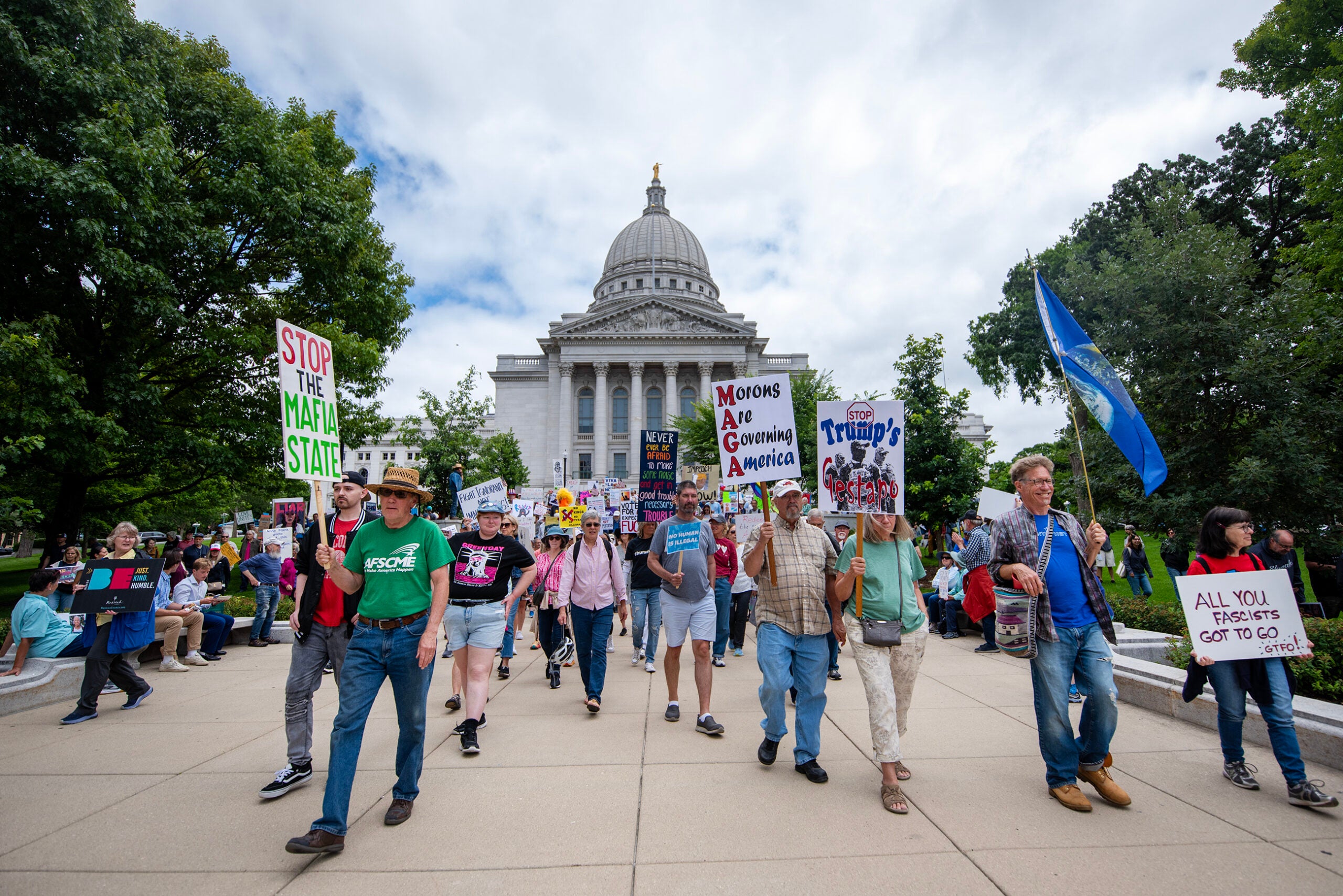On Saturday, a fresh wave of protests took place around the country and in Wisconsin, as thousands of people across the state voiced opposition to President Donald Trump’s policies and executive orders.
This came just two weeks after nationwide “Hands Off!” rallies, which organizers estimate drew up to 5 million people in the largest single-day rally of Trump’s second term.
This weekend, movement organizers focused on pairing marches and sidewalk demonstrations with community action. At many of the Wisconsin protests, including in La Crosse and Manitowoc, participants were encouraged to assemble donations for local food pantries.
News with a little more humanity
WPR’s “Wisconsin Today” newsletter keeps you connected to the state you love without feeling overwhelmed. No paywall. No agenda. No corporate filter.
Douglas McLeod is a professor in the School of Journalism and Mass Communication at the University of Wisconsin-Madison, where he researches media coverage of protests.
“It’s nice to see democracy in action,” he said. “I’m always inspired by peaceful demonstrations that show citizen engagement.”
McLeod’s research shows that how news outlets cover protests has a big impact on how the public views the demonstrations and whether they are ultimately effective. He says traditional media coverage tends to focus on what happened at the protest rather than the issues protestors are raising — something he calls the “protest paradigm.”
That’s a problem, McLeod argues, because it can lead journalists to pay more attention to headline-grabbing content like property destruction or arrests. This can give protesters a bad rap as “troublemakers,” he said, even if the majority of protests are peaceful.
McLeod joined WPR’s “Wisconsin Today” to talk about what he sees at work in this protest movement and what gets lost when the media falls into the “protest paradigm.”
The following has been edited for brevity and clarity.
Kate Archer Kent: At these protests, you saw signs that looked at a range of issues: Social Security, DOGE, Medicaid cuts, cancer research and more. Does it matter that the protesters aren’t rallied around a single issue?
Douglas McLeod: The challenge of any protest group is to get your message out. What are your goals? What are you saying? What are you trying to do? That’s often easiest when you have a single, unified goal that’s very upfront. And everybody says, “This is the protest about issue X.” That doesn’t mean you can’t be diverse in terms of the issues that you care about — you just have to be even more vigilant to make sure that everybody’s on the same page … and get the word out to the public so they understand that this is a multifaceted protest.
KAK: Activists connected with this movement have criticized the media for underplaying the size and scale of these recent protests and calling the movement unfocused. Is there a history of that?
DM: Protest size is a very important determinant of the success of a protest. I would say size and duration, or how long you sustain a protest — a one-day protest tends to come and go. So the size of the crowd and the number of protests is something very important to protesters that they want to get across. They want people to see that this is not an isolated group of people, that this is a broadly shared perspective that is a significant portion of the population.
KAK: You’ve done research into the “protest paradigm.” Can you go more into that? What is it?
DM: It’s a pattern, almost like a cookbook recipe, that journalists often use to tell a protest story. They learn some of that in journalism schools like the school that I teach in, that this is how you go about writing a protest story. They observe their colleagues writing stories this way. They arrive at a protest and one of the things they’re looking for is, to some degree, a chronology of what happened.
And so often they end up focusing on physical events, what we call episodic framing. “This happened, then this happened, then this happened, and then this many people were arrested,” rather than thematic coverage that focuses on the underlying issues. So that’s one of the big characteristics, focus on the episodes and events rather than the underlying themes and issue positions.

KAK: So when you’re not focusing on the issues and what is being said, what gets lost?
DM: What gets lost is: social movements in this country have a long history of being an impetus for positive social change. The obvious example is the Civil Rights Movement, which changed our agenda of a century of Jim Crow laws and other kinds of things. The first thing it did was draw attention to some of the problems, put the issue on the public agenda, got people in Congress [to pay] attention and put it on the congressional agenda. A lot of positive change took place. That translated into the anti-war movement in Vietnam that started to promote a kind of self-reflective criticism of what we were doing in Southeast Asia.
So one of the problems with the protest paradigm coverage, for a lot of protest movements — left-wing and right-wing protest movements — have a hard time getting that critique, their ideas across. And often that leads to frustration, often that leads to property damage, sometimes conflicts with the police. That’s a big focus of most stories that come from the protest paradigm: clashes with police, property damage, blocking traffic and civil disobedience. If they don’t engage in that, they often don’t get covered. When they do get covered for property damage, violent civil disobedience, that coverage is often very negative.
And so what we see as a public tends to be: if they’re peaceful and are trying to say something, we don’t see it. When we do see it, it’s violence, property damage, and it looks fairly destructive. So what I think the long-term consequences are, is that we don’t, as a community, as a society, really appreciate the positive impact that social protests can have in bringing about social change.








